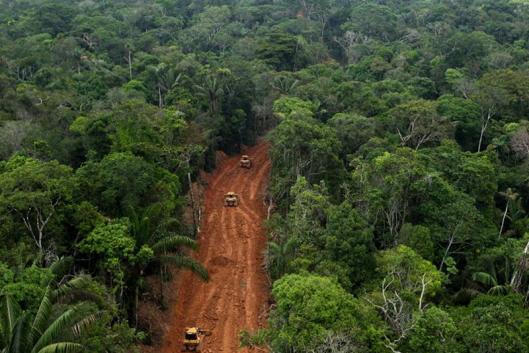It is impossible to think about extraction without thinking about a vast network of accompanying infrastructure, and thus even greater deforestation and destruction.
With the growing dominance of colonial, and later post-colonial empires over lands and peoples in the Global South to extract “resources,” one of the biggest obstacles and challenges has been transport. That is: how to cheaply transport the minerals, rubber, bananas, cotton, wood or oil from the place of extraction to industrial centers where these “resources” are processed,—mostly in the Global North—to then be transported again as final products to consumers.
At present, this is resolved with increasingly larger and more intrusive infrastructure projects. Even projects that are sometimes considered to be infrastructure in themselves, such as hydroelectric dams, in turn need an infrastructure network to access the construction site and to transport the goods (energy)—mostly to other extractive industries or to large urban centers.
The major expansion of infrastructure networks is therefore fomented by the prevailing economy of over-production and -consumption that is ever-expanding, intensifying historical inequalities and discrimination. In other words, more forests and community territories are being destroyed to facilitate the rapid transport of goods. More and more communities are stripped of their forests and livelihoods,—almost always in a violent way—and people are increasingly oppressed through exploitative work.
It is therefore impossible to think about extraction without thinking about a vast network of accompanying infrastructure, and thus even greater deforestation and destruction—which is almost always mentioned in official environmental impact studies. For example, one study confirms that since 2005, the deforestation caused by mining activity in the Brazilian Amazon has been a total of 12 times greater than that which has happened within the mining concessions. This is due—among other things—to the construction of infrastructure (roads, rails, ports, etc.), urban expansion to facilitate the growing workforce, and the development of associated supply chains—such as charcoal to manufacture iron and steel (1).
The opening of access and other roads also aids in the expansion of the agro-industrial frontier and other threats to forests—such as illegal logging or small-scale mining. That is, infrastructure not only directly causes deforestation, but also facilitates the entry of other industries into forests. ‘Road blockades,’ for example—a strategy that peoples who are resisting the entry of an industry onto their lands frequently use—demonstrates the interconnection and direct dependence between extraction and infrastructure. Yet these peoples often face criminalization and violence on the one hand, and on the other, strong state and corporate propaganda that label them as being “anti-development.” However, this ill-termed “development” almost always means extractive and infrastructure mega projects that destroy territories and forests to benefit global elites and corporations.
Likewise, Marxist geographer David Harvey explains how several governments—such as France, Great Britain and the United States—chose to invest precisely in infrastructure when they faced the deep economic crises of modern capitalism (2). Through various urbanization programs and the promotion of construction work, they managed to assimilate the unemployment caused by these crises, and divert the problem of over-accumulation (that is, when there are no incentives for capital to be reinvested).
In the recent financial crisis of 2007-08, the Chinese government—whose economy was deeply affected—created the largest national infrastructure program. Harvey says that new cities, highways and high-speed train rails were built—directly connecting markets in the south and north of the country, as well as coastal and inland areas. The countries that provided China with the raw materials needed to execute this plan—many of which were Latin American countries—managed to keep their economies afloat after this crisis. But this strategy of rapid urbanization had a high cost. Chinese debt skyrocketed, and since 2014, economic problems in most Latin American countries have deepened. To solve this over-accumulation of capital and workforce, since 2014 China has been aggressively investing in infrastructure projects in Africa, Asia and Latin America, offering steel and cement at very low prices. By the way, many projects in the Global South financed with Chinese capital are also already the focus of conflicts, environmental devastation and resistance on the part of affected communities (3).
It is clear that this continuous expansion of extraction and infrastructure—the engine of the capitalist economy—must stop. The idea of connecting regional and international geographies through large-scale infrastructure projects translates into greater exploitation and destruction of territories, forests and peoples.
In this context, it is vital to support the diverse resistance movements that peoples are carrying out to defend their territories and forests. In this sense, perhaps one of the challenges is to achieve greater interconnectivity among movements, communities and groups that are resisting at both the points of extraction and production and the points of consumption.
We hope that this bulletin will help highlight the structural problems of the mega-infrastructure of capitalism, and at the same time, contribute to reflecting on what infrastructure is needed—and created—by and for forest peoples.
(1) Read the study, “Mining drives extensive deforestation in Brazilian Amazon”, Nature Communications, 2017
(2) Harvey D, Realization Crisis and the Transformation of Daily Life, 2019, Space and Culture, 22(2), 126–141.
(3) See, for example, China afianza su influencia en África a golpe de infraestructuras, El País, 2018; “Greening” the Belt and Road initiative?: What about people’s rights?, GRAIN, 2019; Hidroeléctricas: una mirada a la inversión china en la Amazonía de Ecuador, Mongabay Latam, 2017
